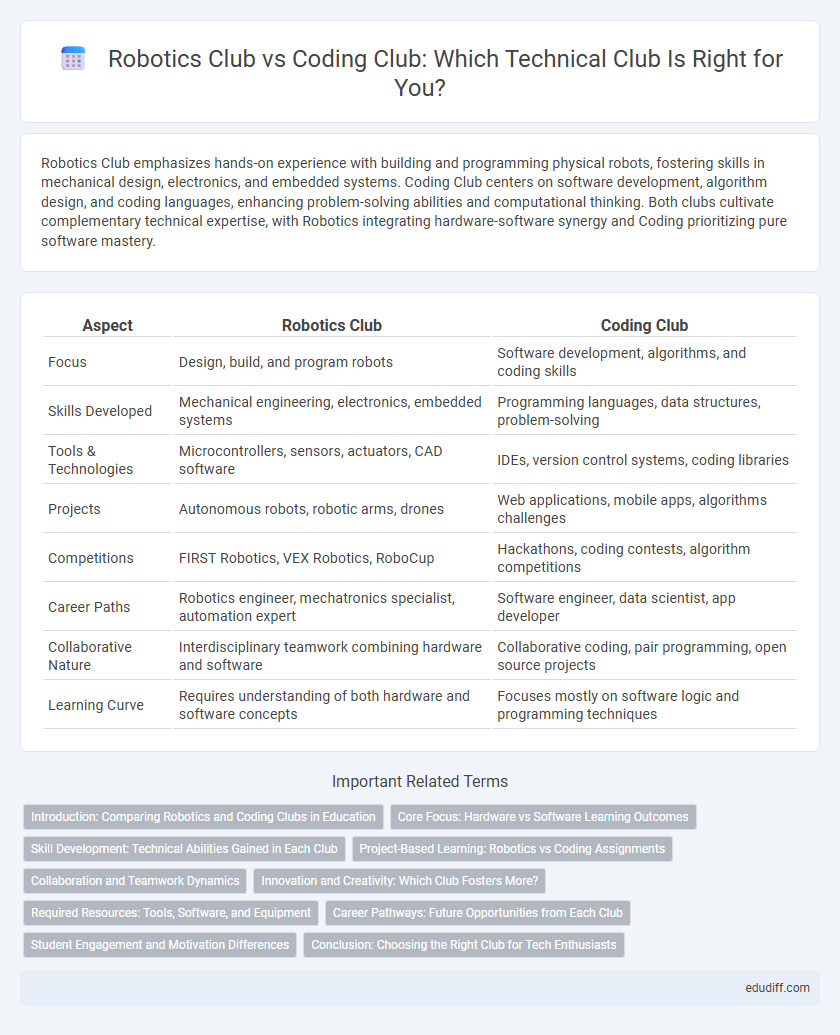Robotics Club emphasizes hands-on experience with building and programming physical robots, fostering skills in mechanical design, electronics, and embedded systems. Coding Club centers on software development, algorithm design, and coding languages, enhancing problem-solving abilities and computational thinking. Both clubs cultivate complementary technical expertise, with Robotics integrating hardware-software synergy and Coding prioritizing pure software mastery.
Table of Comparison
| Aspect | Robotics Club | Coding Club |
|---|---|---|
| Focus | Design, build, and program robots | Software development, algorithms, and coding skills |
| Skills Developed | Mechanical engineering, electronics, embedded systems | Programming languages, data structures, problem-solving |
| Tools & Technologies | Microcontrollers, sensors, actuators, CAD software | IDEs, version control systems, coding libraries |
| Projects | Autonomous robots, robotic arms, drones | Web applications, mobile apps, algorithms challenges |
| Competitions | FIRST Robotics, VEX Robotics, RoboCup | Hackathons, coding contests, algorithm competitions |
| Career Paths | Robotics engineer, mechatronics specialist, automation expert | Software engineer, data scientist, app developer |
| Collaborative Nature | Interdisciplinary teamwork combining hardware and software | Collaborative coding, pair programming, open source projects |
| Learning Curve | Requires understanding of both hardware and software concepts | Focuses mostly on software logic and programming techniques |
Introduction: Comparing Robotics and Coding Clubs in Education
Robotics clubs emphasize hands-on experience with mechanical systems, sensors, and microcontrollers, fostering skills in engineering and physical computing. Coding clubs concentrate on software development, algorithm design, and programming languages such as Python, Java, and C++, enhancing logical thinking and problem-solving abilities. Both clubs provide complementary skill sets crucial for STEM education, enabling students to understand the integration of hardware and software technologies effectively.
Core Focus: Hardware vs Software Learning Outcomes
Robotics Club emphasizes hands-on experience with hardware components such as sensors, microcontrollers, and actuators, fostering practical skills in electronics and mechanical design. Coding Club centers on software development, honing proficiency in programming languages, algorithms, and software engineering principles. The Robotics Club cultivates an integrated understanding of hardware-software interaction, while the Coding Club deepens expertise in software problem-solving and application development.
Skill Development: Technical Abilities Gained in Each Club
Robotics Club enhances practical skills in mechatronics, embedded systems, and sensor integration, fostering expertise in hardware programming and real-time problem-solving. Coding Club emphasizes software development, algorithms, and data structures, building strong proficiency in various programming languages and debugging techniques. Both clubs cultivate critical thinking and technical creativity, but Robotics Club leans towards physical system design while Coding Club focuses on abstract computational logic.
Project-Based Learning: Robotics vs Coding Assignments
Robotics Club emphasizes hands-on project-based learning by engaging members in building and programming physical robots, fostering practical skills in mechanics, electronics, and embedded systems. Coding Club centers on algorithm development and software design through coding assignments that enhance problem-solving and programming proficiency. Both clubs cultivate technical expertise but differ in their approach: tangible hardware integration in Robotics versus abstract software challenges in Coding.
Collaboration and Teamwork Dynamics
Robotics Club and Coding Club foster distinct collaboration and teamwork dynamics tailored to their core activities. Robotics Club emphasizes hands-on, interdisciplinary teamwork involving mechanical design, electronics, and software integration, promoting real-time problem solving and hardware-software synergy. Coding Club centers on algorithm development, software engineering principles, and version control collaboration, encouraging peer code review and modular project structures for scalable, maintainable software solutions.
Innovation and Creativity: Which Club Fosters More?
The Robotics Club fosters innovation by enabling hands-on experience with hardware, sensors, and real-world problem-solving, encouraging creative engineering solutions. The Coding Club emphasizes software development, algorithm design, and computational thinking, promoting creativity through coding projects and software innovation. Both clubs enhance creativity uniquely, with Robotics integrating physical components and Coding focusing on abstract programming challenges.
Required Resources: Tools, Software, and Equipment
The Robotics Club requires specialized hardware such as microcontrollers, sensors, motors, and robotic kits, along with CAD software and programming environments like Arduino IDE or ROS for development and testing. In contrast, the Coding Club primarily depends on powerful computers, a variety of software development tools including IDEs like Visual Studio Code or PyCharm, and access to version control systems such as Git. Both clubs necessitate reliable internet access and collaborative platforms, but the Robotics Club's resource needs extend to physical prototyping materials and electronics labs.
Career Pathways: Future Opportunities from Each Club
Robotics Club offers hands-on experience in mechanical design, electronics, and automation, preparing students for careers in engineering, robotics development, and AI integration. Coding Club emphasizes software development, algorithms, and programming languages, which are essential for careers in software engineering, data science, and cybersecurity. Both clubs enhance problem-solving skills and technical proficiency, providing complementary career pathways in the technology sector.
Student Engagement and Motivation Differences
Robotics Club fosters hands-on interaction with mechanical systems and programming, driving student engagement through tangible project outcomes and collaborative problem-solving. Coding Club emphasizes algorithmic thinking and software development skills, motivating students with coding challenges and real-world application tasks. Engagement in Robotics often appeals to students preferring physical computing and design, whereas Coding attracts those interested in logic and complex software solutions.
Conclusion: Choosing the Right Club for Tech Enthusiasts
Selecting the appropriate club depends on individual interests and career goals within technology; Robotics Club offers hands-on experience with hardware integration and mechanical design, fostering skills in automation and physical computing. Coding Club emphasizes software development, algorithmic thinking, and programming languages, ideal for those focused on software solutions and application development. Tech enthusiasts should evaluate their passion for either hardware innovation or software engineering to make an informed decision that aligns with their professional aspirations.
Robotics Club vs Coding Club Infographic

 edudiff.com
edudiff.com